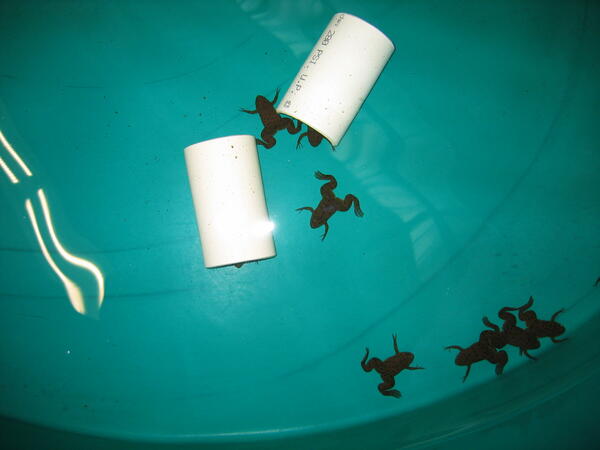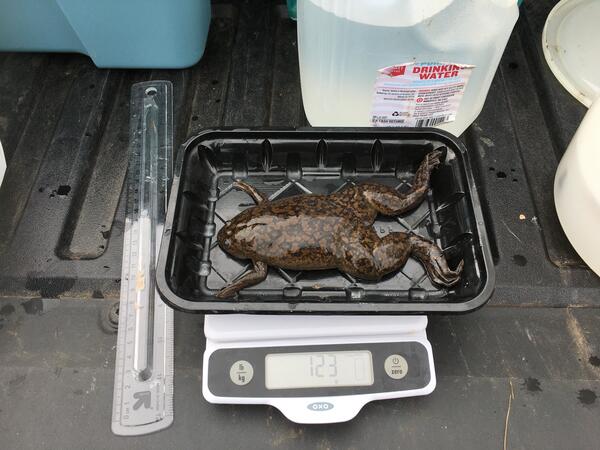The Western Fisheries Research Center (WFRC) research helps uncover the spread and impact of invasive African Clawed Frogs (Xenopus laevis) in Washington. First detected in the U.S. in 1964, African clawed frogs have now made their way to Washington State where they pose a growing threat to local ecosystems.
Eveline (Evi) Emmenegger
Evi was born and raised in Alaska, and spent her summers commercial fishing and working in canneries. Her continued affinities for fish and fascination with the mysteries of microbial pathogens lead to a double major in fisheries and microbiology at college, a graduate degree in fisheries, and ultimately a desire to work in the field of fish pathology.
Research Interests:
Currently Evi is the principal investigator that manages the aquatic biosafety level three (BSL-3) laboratory, one the few facilities in the U.S. built for testing aquatic pathogens that pose a high risk to the environment. Newly introduced aquatic pathogens can be safely study in this secure BSL-3 containment laboratory to determine if these novel pathogens are potential threats to native fish and amphibian species. Her research focuses on studying exotic and invasive fish viruses and the various stress factors that lead to disease outbreaks in fish and herptofauna populations. Her other work includes testing the susceptibility of native and introduced aquatic animal species to novel virus strains, development of a template database for aquatic pathogens, molecular characterization of fish viruses, assessing the genetic variability of fish virus strains, and therapeutic means of combating fish diseases, including the construction and patent of a DNA vaccine for an exotic fish rhabdovirus.
Professional Experience
2001 to Present - Research Microbiologist, Fish Health (Virology) Program, U.S. Geological Survey, Western Fisheries Science Center, Seattle, WA
1994-2001 - Research Microbiologist, Fish Health (Molecular Biology) Program, U.S. Geological Survey, Western Fisheries Science Center, Seattle, WA
1992-1994 - Fisheries Biologist, U.S. Fish & Wildlife Service, National Fisheries Research Center, Seattle, WA
1990-1991 - Microbiologist, Fish Pathology Section, Alaska Department of Fish and Game, Anchorage, AK
1989-1990 - Fish and Wildlife Technician, Commercial Fisheries & Fish Pathology Sections, Alaska Department of Fish and Game, Anchorage, AK
Education and Certifications
B.S. Fisheries, Oregon State University, Corvallis, OR
B.S. Microbiology, Oregon State University, Corvallis, OR
M.S. Fisheries, University of Washington, Seattle, WA
Science and Products
Investigation and Disease Prevention of Spring Viremia of Carp Virus (SVCV)
Spring Viremia of Carp (SVC) - FHP
Koi (Cyprinus carpio koi) - FHP
Yellow Perch (Perca flavescens) - FHP
Sites where Invasive African Clawed Frogs were detected in Western Washington Sites where Invasive African Clawed Frogs were detected in Western Washington
Spring Viremia of Carp Virus (SVCV) Infection Trials of Pacific Northwest Amphibians. Spring Viremia of Carp Virus (SVCV) Infection Trials of Pacific Northwest Amphibians.
Experimental Testing of Endangered Pallid Sturgeon to Viral Hemorrhagic Septicemia Virus Genotype IVb Experimental Testing of Endangered Pallid Sturgeon to Viral Hemorrhagic Septicemia Virus Genotype IVb
Comparative Virulence of Spring Viremia of Carp Virus (SVCV) Genotypes in Two Koi Varieties Comparative Virulence of Spring Viremia of Carp Virus (SVCV) Genotypes in Two Koi Varieties
The Western Fisheries Research Center (WFRC) research helps uncover the spread and impact of invasive African Clawed Frogs (Xenopus laevis) in Washington. First detected in the U.S. in 1964, African clawed frogs have now made their way to Washington State where they pose a growing threat to local ecosystems.
Invasive species present a growing threat to ecosystems worldwide, and the African clawed frog (Xenopus laevis) is no exception. First detected in the U.S. in 1964, African clawed frogs have now made their way to Washington State where they pose a growing threat to local ecosystems.
Invasive species present a growing threat to ecosystems worldwide, and the African clawed frog (Xenopus laevis) is no exception. First detected in the U.S. in 1964, African clawed frogs have now made their way to Washington State where they pose a growing threat to local ecosystems.

Investigation and disease prevention of Spring Viremia of Carp Virus
Investigation and disease prevention of Spring Viremia of Carp VirusTypical clinical signs of SVC disease, exopthalmia and abdominal distension with hemorrhaging seen in a virus-exposed fathead minnow.
Investigation and disease prevention of Spring Viremia of Carp Virus
Investigation and disease prevention of Spring Viremia of Carp VirusTypical clinical signs of SVC disease, exopthalmia and abdominal distension with hemorrhaging seen in a virus-exposed fathead minnow.

Investigation and disease prevention of Spring Viremia of Carp Virus
Investigation and disease prevention of Spring Viremia of Carp VirusTypical clinical signs of disease, pop eye, dermal hemorrhages, abdominal distension, and hemorrhages at the base of fins, displayed in koi infected with spring viremia of carp virus (SVCV).
Investigation and disease prevention of Spring Viremia of Carp Virus
Investigation and disease prevention of Spring Viremia of Carp VirusTypical clinical signs of disease, pop eye, dermal hemorrhages, abdominal distension, and hemorrhages at the base of fins, displayed in koi infected with spring viremia of carp virus (SVCV).
Balancing the scales: Including under-represented herptile species in a One Health approach Balancing the scales: Including under-represented herptile species in a One Health approach
Host jump of an exotic fish rhabdovirus into a new class of animals poses a disease threat to amphibians Host jump of an exotic fish rhabdovirus into a new class of animals poses a disease threat to amphibians
A new sturgeon herpesvirus from juvenile Lake Sturgeon Acipenser fulvescens displaying epithelial skin lesions A new sturgeon herpesvirus from juvenile Lake Sturgeon Acipenser fulvescens displaying epithelial skin lesions
Susceptibility of Pallid Sturgeon to viral hemorrhagic septicemia virus genotype IVb Susceptibility of Pallid Sturgeon to viral hemorrhagic septicemia virus genotype IVb
Comparative virulence of spring viremia of carp virus (SVCV) genotypes in two koi varieties Comparative virulence of spring viremia of carp virus (SVCV) genotypes in two koi varieties
Analytical validation of two RT-qPCR tests and detection of spring viremia of carp virus (SVCV) in persistently infected koi Cyprinus carpio Analytical validation of two RT-qPCR tests and detection of spring viremia of carp virus (SVCV) in persistently infected koi Cyprinus carpio
Virulence of a chimeric recombinant infectious haematopoietic necrosis virus expressing the spring viraemia of carp virus glycoprotein in salmonid and cyprinid fish Virulence of a chimeric recombinant infectious haematopoietic necrosis virus expressing the spring viraemia of carp virus glycoprotein in salmonid and cyprinid fish
Identification of the major capsid protein of erythrocytic necrosis virus (ENV) and development of quantitative real-time PCR assays for quantification of ENV DNA Identification of the major capsid protein of erythrocytic necrosis virus (ENV) and development of quantitative real-time PCR assays for quantification of ENV DNA
Experimental infection of six North American fish species with the North Carolina strain of spring Viremia of Carp Virus Experimental infection of six North American fish species with the North Carolina strain of spring Viremia of Carp Virus
Molecular identification of erythrocytic necrosis virus (ENV) from the blood of Pacific herring (Clupea pallasii) Molecular identification of erythrocytic necrosis virus (ENV) from the blood of Pacific herring (Clupea pallasii)
Susceptibility of Koi and Yellow Perch to infectious hematopoietic necrosis virus by experimental exposure Susceptibility of Koi and Yellow Perch to infectious hematopoietic necrosis virus by experimental exposure
Virulence of viral hemorrhagic septicemia virus (VHSV) genotypes Ia, IVa, IVb, and IVc in five fish species. Virulence of viral hemorrhagic septicemia virus (VHSV) genotypes Ia, IVa, IVb, and IVc in five fish species.
AquaPathogen X: A Template Database for Tracking Field Isolates of Aquatic Pathogens AquaPathogen X: A Template Database for Tracking Field Isolates of Aquatic Pathogens
Science and Products
Investigation and Disease Prevention of Spring Viremia of Carp Virus (SVCV)
Spring Viremia of Carp (SVC) - FHP
Koi (Cyprinus carpio koi) - FHP
Yellow Perch (Perca flavescens) - FHP
Sites where Invasive African Clawed Frogs were detected in Western Washington Sites where Invasive African Clawed Frogs were detected in Western Washington
Spring Viremia of Carp Virus (SVCV) Infection Trials of Pacific Northwest Amphibians. Spring Viremia of Carp Virus (SVCV) Infection Trials of Pacific Northwest Amphibians.
Experimental Testing of Endangered Pallid Sturgeon to Viral Hemorrhagic Septicemia Virus Genotype IVb Experimental Testing of Endangered Pallid Sturgeon to Viral Hemorrhagic Septicemia Virus Genotype IVb
Comparative Virulence of Spring Viremia of Carp Virus (SVCV) Genotypes in Two Koi Varieties Comparative Virulence of Spring Viremia of Carp Virus (SVCV) Genotypes in Two Koi Varieties
The Western Fisheries Research Center (WFRC) research helps uncover the spread and impact of invasive African Clawed Frogs (Xenopus laevis) in Washington. First detected in the U.S. in 1964, African clawed frogs have now made their way to Washington State where they pose a growing threat to local ecosystems.
The Western Fisheries Research Center (WFRC) research helps uncover the spread and impact of invasive African Clawed Frogs (Xenopus laevis) in Washington. First detected in the U.S. in 1964, African clawed frogs have now made their way to Washington State where they pose a growing threat to local ecosystems.
Invasive species present a growing threat to ecosystems worldwide, and the African clawed frog (Xenopus laevis) is no exception. First detected in the U.S. in 1964, African clawed frogs have now made their way to Washington State where they pose a growing threat to local ecosystems.
Invasive species present a growing threat to ecosystems worldwide, and the African clawed frog (Xenopus laevis) is no exception. First detected in the U.S. in 1964, African clawed frogs have now made their way to Washington State where they pose a growing threat to local ecosystems.

Investigation and disease prevention of Spring Viremia of Carp Virus
Investigation and disease prevention of Spring Viremia of Carp VirusTypical clinical signs of SVC disease, exopthalmia and abdominal distension with hemorrhaging seen in a virus-exposed fathead minnow.
Investigation and disease prevention of Spring Viremia of Carp Virus
Investigation and disease prevention of Spring Viremia of Carp VirusTypical clinical signs of SVC disease, exopthalmia and abdominal distension with hemorrhaging seen in a virus-exposed fathead minnow.

Investigation and disease prevention of Spring Viremia of Carp Virus
Investigation and disease prevention of Spring Viremia of Carp VirusTypical clinical signs of disease, pop eye, dermal hemorrhages, abdominal distension, and hemorrhages at the base of fins, displayed in koi infected with spring viremia of carp virus (SVCV).
Investigation and disease prevention of Spring Viremia of Carp Virus
Investigation and disease prevention of Spring Viremia of Carp VirusTypical clinical signs of disease, pop eye, dermal hemorrhages, abdominal distension, and hemorrhages at the base of fins, displayed in koi infected with spring viremia of carp virus (SVCV).







